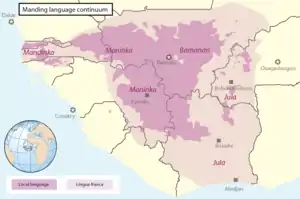Manding languages
The Manding languages (sometimes spelt Manden)[1][2] are a dialect continuum within the Mande language family spoken in West Africa. Varieties of Manding are generally considered (among native speakers) to be mutually intelligible – dependent on exposure or familiarity with dialects between speakers – and spoken by 30 to 40 million people in the countries Burkina Faso, Senegal, Guinea-Bissau, Guinea, Liberia, Ivory Coast and the Gambia.[3] Their best-known members are Mandinka or Mandingo, the principal language of The Gambia; Bambara, the most widely spoken language in Mali; Maninka or Malinké, a major language of Guinea and Mali; and Jula, a trade language of Ivory Coast and western Burkina Faso. Manding is part of the larger Mandé family of languages.
| Manding | |
|---|---|
| Geographic distribution | West Africa |
| Linguistic classification | Mande
|
| Subdivisions |
|
| ISO 639-2 / 5 | man |
| Glottolog | mand1435 |
 Map of the Manding language continuum | |
Subdivisions
The Manding languages, the differences from one another and relationships among them are matters that continue to be researched. In addition, the nomenclature is a mixture of indigenous terms and words applied by English and French speakers since before the colonisation of Africa, which makes the picture complex and even confusing.
The Mandinka people speak varieties from the first two groups. The differences between the western and eastern branches manifest themselves primarily phonetically. While dialects of the western group usually have 10 vowels (5 oral and 5 long/nasal), the eastern group, typified by Bambara, has 14 vowels (7 oral and 7 nasal):
- Manding-West
- Kassonke – Western Maninka (Mali, Senegal)
- Mandinka (Senegal, Gambia, Guinea Bissau)
- Kita Maninka (Mali)
- Jahanka (Guinea, Senegal, Gambia, Mali; one of several dialects under this name)
- Manding-East
- Marka (Dafin) (Burkina Faso, Mali)
- Bambara–Dyula (Northeastern Manding; Mali, Burkina Faso, Ivory Coast)
- Eastern Maninka (Southeastern Manding; multiple varieties in Mali, Guinea, Ivory Coast)
- Bolon (Burkina Faso)
In addition, Sininkere (Burkina Faso) is of an unclear placement within Manding.
Writing
The Manding languages have a strong oral tradition, but also have written forms: adaptations of the Arabic alphabet and the Latin alphabet[4] and at least two indigenous scripts.
- The Arabic alphabet was introduced into the region with the arrival of Islam and was adapted to write in the Manding languages as the Ajami, which is still commonly used for Mandinka.
- The Latin alphabet was introduced into the region following European conquest and colonization. It is used fairly widely, with "official" versions in many countries, for teaching, literacy and publication.
- The N'Ko alphabet, developed in 1949 by Solomana Kante, is designed to write Manding using a common literary standard comprehensible to speakers of all these varieties. It is gaining popularity.[5]
- A lesser-known alphabet for Bambara was developed in the early 20th century but is not used.[6]
See also
- Proto-Mandekan reconstructions (Wiktionary)
- Mande languages
- N'Ko language
References
- Fairhead, James; Leach, Melissa (1996-10-17). Misreading the African Landscape: Society and Ecology in a Forest-Savanna Mosaic. CUP Archive. pp. xviii. ISBN 9780521563536.
- Belcher, Stephen Paterson (1999-01-01). Epic Traditions of Africa. Indiana University Press. pp. 89. ISBN 0253212812.
manden manding.
- "Mandé Language Family: Manding". www.sil.org. Archived from the original on 21 January 2013. Retrieved 1 January 2018.
- Donaldson, Coleman (2017) "Orthography, Standardization and Register: The Case of Manding." In Standardizing Minority Languages: Competing Ideologies of Authority and Authenticity in the Global Periphery, edited by Pia Lane, James Costa, and Haley De Korne, 175–199. Routledge Critical Studies in Multilingualism. New York, NY: Routledge.
- Donaldson, Coleman (2017) Clear Language: Script, Register and the N’ko Movement of Manding-Speaking West Africa. Doctoral Dissertation, Philadelphia, PA: University of Pennsylvania.
- N'Ko Language Tutorial: Introduction
External links
- PanAfrican L10n page on Manding
- Resources to learn Bambara, Dioula and Malinké — An ka taa Project